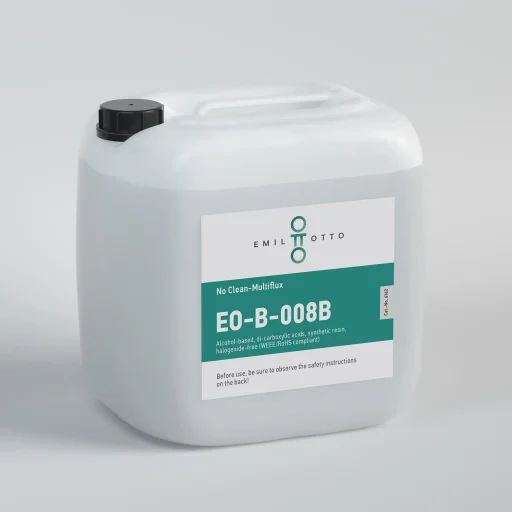No Clean-Flux, alcohol-based
Di-carboxylic acid complex, synthetic resin, halogenide-free (WEEE/RoHS compliant)
Type ISO-9454: 1231 // DIN EN 61190-1-1: (acc. J-STD 004): [IPC: REL0]

| Appearance: | colourless to reddish, clear liquid |
| Solids content: | 2.9 – 3.2 wt.-% |
| Acid number: | 23 – 27 mg KOH/g |
| Density at 20 °C: | 0.795 (+/- 0.003) g/ml |
| Activators: | di-carboxylic acid complex with synthetic resin |
| Solvent: | short chain alcohols |
| Flash point: | 12 °C |
| Durability: | 24 months |
| Storage conditions: | at 5 – 25 °C, cool and dry, originally sealed, fire protection and Ex-protective regulations must be observed |
| Working temperature: | at room temperature (usually 20 – 25 °C) |
EO-B-008B is a flux of the latest generation. It is a high performance No Clean flux based on alcohol with di-carboxylic acid and synthetic resin. This flux was used for selective and wave soldering processes as well as dip soldering.
The application can be carried out by any usual application method (except foams). The solids content is 3%. EO-B-008B is totally free from corrosion action.
Information on the ingredients (hazardous substances), safe handling, storage, transport and disposal can be found in the current safety data sheet (SDS, SDS, MSDS).
Recommendations for the processing of this flux:
This flux is very versatile, both in wave soldering and special applications are good results. The generally valid rule to choose applied flux quantities as low as possible, also applies to this product.
Recommended parameters for wave soldering.
Spray fluxing: When dosing, the amount of flux initially to 20 – 40 ml / min. Adjust the uniform flux distribution on the printed circuit board (if necessary test with thermal paper) and then correct to the optimum amount.
Preheating: For “simple” PCBs, a preheat temperature of 80 – 110 °C, recommended for “more complex” boards from 100 – 130 °C on the top side of the PCB. The use can be made both in leaded and lead-free solder systems.